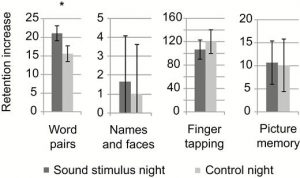
24 Oct Enhanced Memory Consolidation Via Automatic Sound Stimulation During Non-REM Sleep
Playing music to plants has been theorised to help grow luscious flowers and vibrant produce. Humans have also listened and enjoyed music for thousands of years often using to relax and help them fall asleep.
But is there a specific type of music should we listen to and could certain genres be responsible for developing different skills?
Cue the Matrix soundtrack – could we simply press play on an album and effectively learn ju-jitsu, similarly to downloading the skill like the Hollywood blockbuster?
Well an article published in the Journal of sleep by Leminen et al has started looking into understanding these possibilities. A bit of a stretch to something out of the Matrix but they have found certain learning benefits by applying a sound at specific intervals during a person’s sleep.
Certain sleep stages are characterized by waveforms present in the brainwaves. During stage 2, sleep spindles are present and as we reach deeper stage 3 sleep, we see slow frequency delta waves appear. These spindles and slow waves have been shown to be crucial for memory consolidation. Studies have shown they are regularly seen to occur on an (Electroencephalogram) EEG recording at the same time as the hippocampus (the part of the brain mainly associated with memory) is active as seen on an fMRI scan.
In this recent study, fifteen participants undertook polysomnography for 3 nights in the laboratory, each night 1 week apart. Night 1 was a familiarisation night. Night 2 and 3 were randomised to either control or stimulus first. Learning was tested with 4 memory tasks (word pairs, serial finger tapping, picture recognition and face-name association). These were done 30 minutes after waking to assess the impact of the auditory stimulus. Subjective sleep quality and mood changes were also measured with questionnaires. During the stimulus night, auditory stimuli were adjusted and targeted by a specific algorithm to deliver the sounds during the negative peak of slow waves during Stage 3 NREM. The sounds were at a volume low enough to not wake the subject. No sounds were presented during the control night.
The results showed that the sound stimulation increased Slow wave sleep and spindle activity but didn’t have a large impact on sleep architecture. Memory performance tests showed that there was an improvement in the word pair task but not in the other tasks. There was found to be no effect on subjective sleep quality or mood.
Leminen et al hypothesise that the sounds delivered during the evoked slow wave could have triggered sleep spindles which may help in memory consolidation. The specific time the sounds were delivered may have been responsible for the type of learning task which showed improvements. In this case the verbal association task improved but the other more complex and procedural tasks didn’t. It is likely that by targeting sound delivery during other sleep stages such as REM sleep may show improvements in learning other types of tasks.
A lot more research is required in this area but the authors successfully implemented an automatic algorithm to deliver the sound stimulus which removes a lot of labour intensive manual analysis. It may open the door for more complicated sound sequences targeted throughout all stages of sleep to boost memory and learning consolidation of all tasks.
https://academic.oup.com/sleep/article/2965202/Enhanced-Memory-Consolidation-Via-Automatic-Sound


